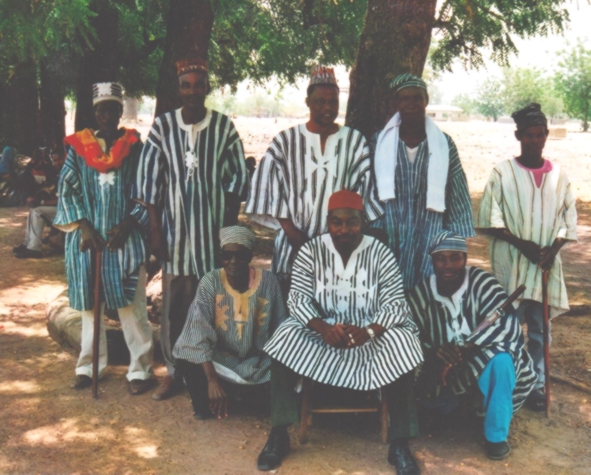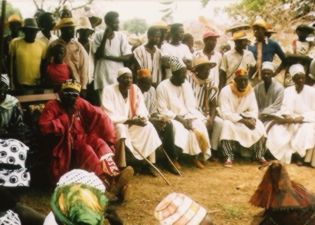
The Wiaganaab and some of his
kambonnalima is paying a visit to the Sandemnaab
Franz Kröger
The Administration of Chiefdoms
 |
|
The Wiaganaab and some of his kambonnalima is paying a visit to the Sandemnaab
|
On February 9th, 2006 I was able to take part in the installation of the court-officers of the Habondeng chief (Yikpabongo, Komaland). I had the impression that many rituals and above all the names of the officers were adopted from the Mamprusi. Among the new officers were also some kambonnaling1 and I was told that previously these people had been military commanders of the chief’s warriors. There is no doubt that the Konni kambonnaang is linguistically related to the Buli kambonnaab, but the duties of a Bulsa kambonnaab, also called a subchief, seem to be different from those of a Koma kambonnaang. This persuaded me to pay a visit to the Wiaganaab, whom for many years I have called my friend, and ask him to give me some information about the structure and organisation of a chiefly court. The first Bulsa kambonnalima were installed by the British colonial administration. Today their office is related to a precisely defined area in which they have taken over particular tasks commissioned by the chief. The Wiaga chief has 16 kambonnalima (see box), who were elected by the heads of compounds (yeri nyam) in a way similar to how chiefs are elected, which means that on election day a candidate is placed under a tree and all of those men who vote for him join him. The votes prescribe who will be the next kambonnaab for a particular section. A kambonnaab can be deposed by the chief and his elders in consensus with the people.
|
Kambonnaab-administration areas in Wiaga 1. Yisobsa-Guuta (Yisobsa-West) 2. Yisobsa-Kpaandem (Yisobsa-East) 3. Sinyangsa 4. Wabilinsa 5. Yimonsa 6. Farinsobsa 7. Farinmonsa 8. Chiok-North 9. Chiok-South 10. Kum 11. Longsa 12. Zuedema 13. Tankansa 14. Kpalinsa 15. Zamsa 16. Baandem |
In addition to the kambonnalima the court officers, also called elders (nisomba) assist the chief in administering the village affairs falling under the responsibilities of a chief. In Wiaga this body of elders consists of the following people:
1) Biisitieroa: the "linguist" or "interpreter", who, in a speech, repeats the chief’s quietly spoken phrases in a loud voice
2) Nisom-naab: the leader of administration
3) Nansiung-naab: He must be from the chief’s compound and represents the interests of this compound.
4) Tugoruk-naab: war leader
5) Bimbaansa-naab: youth leader
6) Naayogsum-naab: the person responsible for the chief’s umbrella
7) Tantieroa: messenger; under him there are some sub-messengers
8) Mangazia: the women’s leader; she does not take part in all meetings of the elders.
9-11) Three representatives of the kambonnalima (subchiefs)
12) The secretary: He records the minutes of the proceedings.
On principle, the structure of this advisory board is similar across all Bulsa villages. In Sandema, there are, however, more kambonnalima (22 in 2011).
Traditional councils (which today are called area councils) were institutions which had been independent from the chiefly court. Today, however, these councils are summoned by the chief and their formerly independent committees now usually consist of the chief’s elders. There are eight area councils in the Bulsa District, which together make up the District Assembly. One council may comprises deputies from one, two or three chiefdoms, e.g.:
one council for Sandema
one council for Chuchuliga
one council for Fumbisi
one council for Wiaga and Kadema
one council for Bachonsa, Doninga and Siniensi
one council for Gbedema and Kanjaga
 |
|
The Sandemnaab (in red) and some of his elders
|
For the future some very drastic changes are under discussion. It has been proposed to give all Bulsa chiefs the status of a paramount chief. This would mean that the current leading position of the Sandemnaab and his influence on the elections of the other chiefs would have to be given up.
Another plan is to separate the present Bulsa District, the largest in the Upper East Region, into a Northern and a Southern district. Even today the Bulsa District forms two constituencies in all elections: Bulsa North and Bulsa South. To make the number of voters in both constituencies approximately equal some sections of Wiaga (e.g. Zamsa) were added to the Bulsa South Constituency. Now people of Wiaga fear that these sections may also become part of the Southern Bulsa District.
The problem of the Bulsa who live in villages outside the Bulsa District will be discussed in a separate article of Buluk 6.
Link: Sections of the Bulsa District